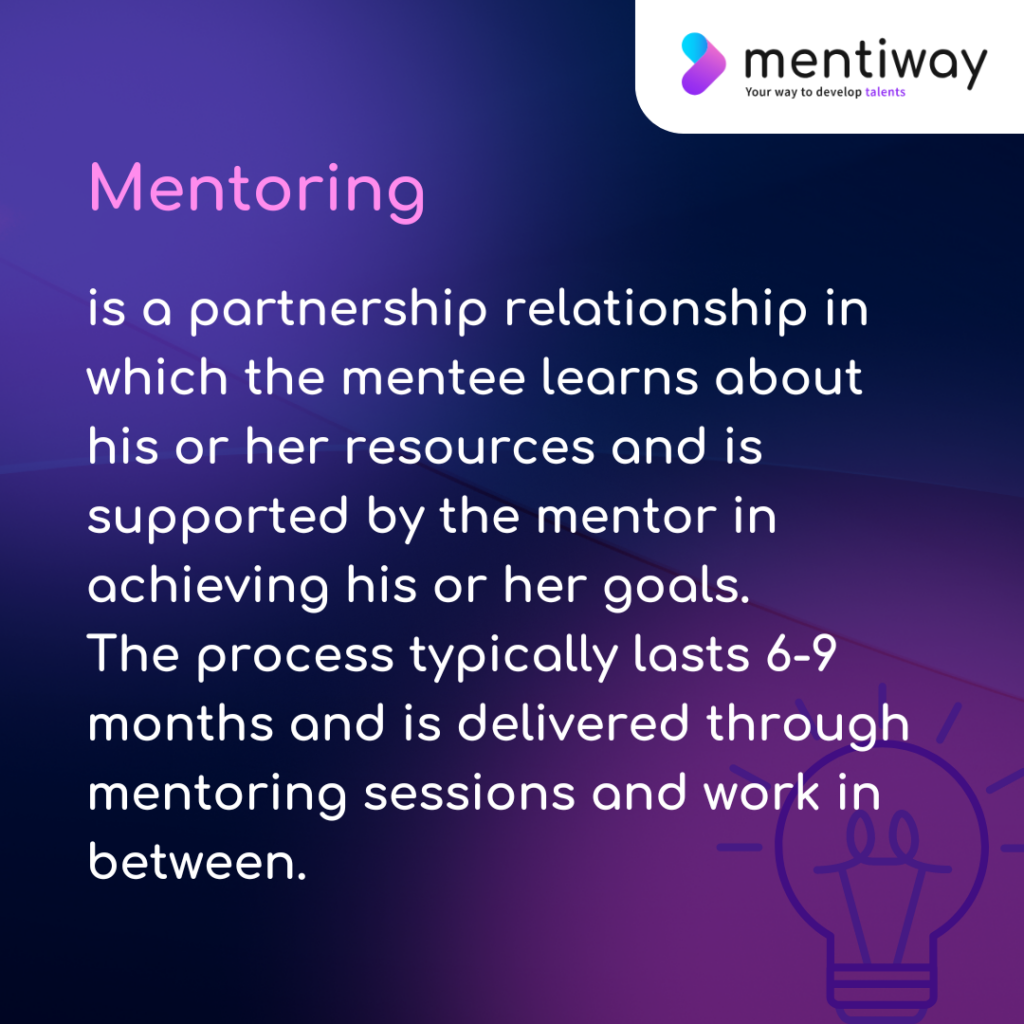How do you find and choose a Mentor for yourself?
Mentoring is an extremely effective form of personal development, as it combines a number of benefits. It is not only access to the knowledge and experience of the Mentor, but also getting to know oneself better, using elements of coaching, the opportunity to test the learned knowledge in practice and getting ongoing feedback from a person with more experience.
However, as a result of its premises, mentoring requires commitment on the part of the Mentee, and one of the first steps requiring just this proactivity is to find and choose the right Mentor at all.
In this article, we will take a closer look at this topic starting with the issue of finding a Mentor and the mentoring program more broadly, his/her selection, the first meetings, ending with some tips on what to do to make the mentoring process as effective as possible for the Mentee.
Mentoring from a Mentee’s perspective
Before you go any further, I encourage you to take a look at a few more resources on mentoring that you may find useful:
- What mentoring is and what it looks like in practice
- What are the benefits of mentoring for Mentees
- How to set development goals for the mentoring process
These materials should be consulted by the Mentee first, before he or she even proceeds to select a Mentor.
How to FIND a Mentor/Mentee?

I assume that you already know what mentoring is, you know the roles, responsibilities and required competencies of the Mentee. You also already have more or less defined your goals for participating in the mentoring process.
Another question you may ask yourself in such a situation is how to find a Mentor for yourself in the first place.
Although mentoring is a relationship between two people, it is most often necessary to participate in a larger mentoring program to find a Mentor.
Participation in a mentoring program
Mentoring programs are initiatives organized by companies, foundations or universities that bring together “in one place” both people who want to learn something from people with more experience and Mentors who, most often pro bono, want to share their knowledge.
Participating in an open mentoring program is probably the easiest way to find a Mentor/Mentee for yourself.
Mentoring program in your company
A second option is to participate in a mentoring program organized at your employer. More and more companies are beginning to recognize the benefits of mentoring – not just for Mentees – and are choosing to organize their own internal mentoring programs.
In these initiatives, most often both Mentees and Mentors are individuals working in the same company. Importantly, in professional mentoring programs, Mentors are never the Mentees’ superiors; in fact, efforts are made to ensure that there is no project relationship between the two people in the pair.
If you are interested in this route, then contact your HR, L&D or innovation team and find out if such a program is being organized in your company. If not, it’s worth suggesting it. Sometimes people in HR are thinking about the possibility of organizing such a program, and every additional vote will bring the company closer to launching this initiative.
Finding a Mentor on your own
The last option is to try to find the Mentor on your own. Unfortunately, this is still not an effective option. Mentoring is still a relatively unknown method of development and there are no platforms offering a wide selection of mentors.
There always remains the option of finding an expert in your chosen field on your own (for example, through LinkedIn), but you have to reckon with potential shortcomings in the experience and mentoring workshop of such candidates.
How to SELECT a Mentor?
If one decides to participate in a mentoring program – whether it is an open mentoring program or a corporate program – one can encounter two possibilities for forming mentoring pairs:
- The organizers select the mentoring pairs themselves on the basis of the applications received,
- then Mentees select Mentors from the list of available individuals.
Sometimes the reverse option happens, in which Mentors choose Mentees, but this is very rare.
So let’s address the situation in which it is the Mentee who chooses the Mentor.
What to consider when choosing a Mentor?
Usually, when a Mentee participates in a mentoring program, he or she does not personally know the Mentors from whom he or she can make a selection. In such a case, the selection is based primarily on the business cards of the Mentors presented by the organizers – their answers to the questions given in the program application forms.
Based on this information, the Mentee should first of all take into account before choosing:
- The competencies that the Mentor lists in his business card, and in fact the convergence of these competencies with the Mentee’s needs.
- Mentor’s professional experience, industry convergence (if relevant) and confirmation of the indicated competencies in the professional path.
- Justification for wanting to participate in the program.
- Mentor’s expectations of Mentee.
- Communicated values relevant to the Mentor and their interests.
Of course, the presence of answers for these areas depends on the content of the recruitment forms, and such fields will not always be available in Mentors’ business cards.
Alternatively, it is worthwhile to further deepen the above information with experience from the Mentor’s description on LinkedIn, if the Mentor has such a profile available and findable.
How to ASSESS if the selected Mentor is right for you?
The next step on the road to building a relationship is the Mentee’s first conversation with the Mentor. This is also a good opportunity to assess whether the relationship even makes sense.
In some cases, this first meeting will take place as part of the first mentoring session proper already. Sometimes, however, organizers still introduce the possibility of zero sessions to facilitate the decision to form a pair.
Zero/initial mentoring session
A session zero is a meeting shorter than a standard session, usually lasting no more than 30 minutes, the purpose of which is to get to know the potential couple and decide together to establish a mentoring relationship.
Most often, zero sessions are found in those mentoring programs in which the formation of pairs is based on the selection of Mentors by Mentees. In such a case, the zero session is, so to speak, a summary with a final confirmation or not of this selection.
Typically, such a meeting is structured as follows:
- Greeting and introducing yourself
- Mentee talks about himself with consideration:
- their current situation,
- Your short- and long-term goals
- and initial goals for the mentoring process.
- The Mentor talks about himself with consideration:
- of his past experience,
- experience and knowledge in areas that coincide with Mentee’s goals,
- of their experience in previous mentoring processes.
- Vision and expectations for the mentoring process.
- Both Mentee and Mentor should present their expectations for the mentoring process, their preferred vision of how the process should go, the involvement of both parties.
- Next steps
- Determine the next steps – for example, deciding on the formation of a couple already during the zero session, or planning the next steps and when such a decision will be made by both parties.
First mentoring session
If the mentoring program does not involve a zero meeting, the couple first meets during the first mentoring session.
The purpose of this session is, on the one hand, to actually get to know each other – similar to the zero-opener session, but that’s where the similarities end. In addition to getting to know each other, the first session is the actual start of the process, including setting the rules for further cooperation and signing the mentoring contract.
In order for the first session to meet its objectives, we recommend the following course of action:
- Greeting and introducing yourself
- Mentee talks about himself with consideration:
- their current situation,
- Your short- and long-term goals
- and initial goals for the mentoring process.
- The Mentor talks about himself with consideration:
- of his past experience,
- experience and knowledge in areas that coincide with Mentee’s goals,
- his experience in previous mentoring programs.
- Vision and expectations for the mentoring process
- Both Mentee and Mentor should present their expectations for the mentoring process, their preferred vision of how the process should go, the involvement of both parties.
- Agreement and “signing” of mentoring contract
- The aforementioned visions and expectations should be written down in the form of a contract.
- In addition, both people should accept the general terms of the mentoring relationship, taking into account the principles of confidentiality and ethics.
- Prepare to work on goals including possible “homework” for the Mentee before the next session.
Mentees’ inability to choose Mentors?
In most of the mentoring programs we have the opportunity to support as Mentiway, mentoring pairs are selected by the organizers. To those new to the world of mentoring, this may seem unnatural, and there are often signals of surprise at the beginning of the program from Mentees who feel deprived of the right to choose a Mentor.
However, it should be kept in mind that mentoring programs are often very large in scale involving dozens or even hundreds of people. Allowing Mentees to select Mentors causes a lot of confusion, chaos and creates more problems if only due to the “occupation” of Mentors by Mentees who applied first.
That is why organizers very often decide to impose mentoring pairs.
Typically, this selection is supported by the Mentiway platform, which, using proprietary algorithms, creates suggested pairs in such a way that everyone is satisfied – so that each Mentee gets a Mentor who is able to respond to the reported needs.
Interestingly, this way of creating mentoring pairs is met with very positive evaluations from Mentiway users. As many as 94% of participants positively evaluate the selection (imposition) of a mentoring pair, and the average rating on a scale of 1 to 10 reaches 9.3 points. The needs for change are on a case-by-case basis and are usually due to conflicts of interest and other such reasons.
How do you get the most out of a mentoring relationship?
In conclusion, if you have the opportunity to choose a Mentor, first of all, pay attention to the coincidence of his knowledge and experience with your needs. And if you don’t have such an opportunity, keep an open mind about the potential relationship, see its benefits.
And above all, at the beginning, make sure you understand what mentoring is, what your role in it is, and that you are ready to take part in the process on these terms.
As a reminder:
Mentee’s role:
- Building self-awareness – learning about your resources and limitations, your motivations, analyzing your own behavior and beliefs,
- Learning – development of knowledge and skills,
- Implementation of goals set together with the Mentor.
Requirements and attitudes expected for Mentee:
- be motivated,
- Be involved and attentive,
- Initiate contact with the Mentor, be a proactive party in the process,
- Be open to a different point of view and to new ideas, concepts, attempts at behavior, take challenges, test, try,
- Learn from successes and failures,
- Have a willingness to self-reflect, to think about their own behavior, thoughts and feelings.
Hi, my name is Thomas. I am the Co-Founder of Mentiway. We are happy to share our knowledge and support organisations on their way to success! 💪 If you are interested in how to efficiently and effectively implement a mentoring programme in your organisation using technology:








